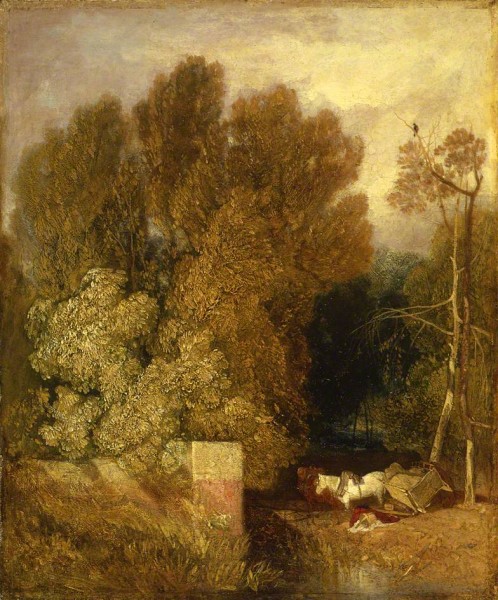
(c) Norfolk Museums & Archaeology Service (Norwich Castle Museum & Art Gallery); Supplied by The Public Catalogue Foundation
John Sell Cotman ‘The Mishap’ (1824-28) : Norwich City Art Gallery
Cotman has been a favourite artist of mine for a very long time and continues to intrigue me. I grew up in Suffolk, in the rural north of that county. The painting collection at nearby Norwich included many works by the ‘Norwich School’ – of which Cotman, along with John ‘Old’ Crome and others, were leading members – and their work reflected my own experience and love for the rolling and intimate landscape of the area. For my undergraduate dissertation I explored in some depth the ‘reserve’ collection of Norwich School works at the Norwich Art Gallery – an exhilarating and formative period for me personally.
In exploring the many paintings, watercolours, and drawings, I found Cotman particularly fascinating – and in the works on paper I found particular resonance. I am not alone as the majority of works illustrated in art history books are his works on paper. But the work illustrated here shows a different side to Cotman – one that is more intimate and, I think, humorous. In some respects it is of the same intimacy, with the countryside, its activities, and its people, as is seen in, for instance, Constable’s ‘Haywain’ – another East Anglian artist of the period. The ‘short’ brush-strokes and thick paint is typical of Norwich School artists but in this work there is an intriguing extra element – focussed on the right-hand side of the painting. Here there is a difference between Constable’s depiction of a farm-cart and that of Cotman – Constable’s is a well-maintained vehicle pausing in the river to ‘refresh’ the wooden wheels – Cotman’s cart is apparently not well-maintained, the wood of the wheels are clearly not ‘refreshed’ and have fallen off when attempting to cross the stream. To be fair, the stream in Cotman’s work is deep, narrow, and between steep banks whereas Constable’s river has no steep banks. Mishaps of this sort must have been a common occurrence and hazard, as with to-days farm tractors and carts, but such occurrences are not usually recorded in the early nineteenth century. I find it not only humorous but very human. Another element, on the right hand side of the work, is important, and reflects Cotman’s familiarity with seventeenth century Dutch landscape works, seen in the collection of his patron, the Yarmouth banker Dawson Turner. That is the black bird, probably a raven, perched at the top of a tree – a warning of tragedy and an omen of human frailty. Of course all these elements in the paintings, including the tall dead tree on the right hand side and the sloping stones on the left hand side, towards the bottom of the painting, are part of traditional ‘composition’ – focussing and leading the spectator’s eye – of an oval within the rectangle of the canvas.
This work – not one of Cotman’s more famous works or striking in any way – is another hidden treasure in our art galleries; perhaps more indicative of the human condition than more showy, and more shown, works.
